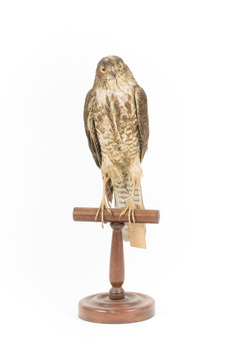Historical information
This specimen is a Brown Goshawk juvenile. The Brown Goshawk is widely distributed across Australia, Wallacea, New Guinea, New Caledonia, Vanuatu, and Fiji. In Australia, it predominantly inhabits eucalypt forests, woodlands, farmland, and urban areas, while in the Pacific, it is primarily associated with rainforest environments. Historically, it was also present on Norfolk Island until around 1790, potentially representing an undescribed subspecies. However, the limited material available—consisting of a single historical skin and nine subfossil bones—precludes confirmation through scientific analysis.
This specimen was originally identified as a Nankeen Kestral and is catalogued as such in the original Public Library and Burke Museum catalogue.
The specimen is part of a collection of almost 200 animal specimens that were originally acquired as skins from various institutions across Australia, including the Australian Museum in Sydney and the National Museum of Victoria (known as Museums Victoria since 1983), as well as individuals such as amateur anthropologist Reynell Eveleigh Johns between 1860-1880. These skins were then mounted by members of the Burke Museum Committee and put-on display in the formal space of the Museum’s original exhibition hall where they continue to be on display. This display of taxidermy mounts initially served to instruct visitors to the Burke Museum of the natural world around them, today it serves as an insight into the collecting habits of the 19th century.
Significance
This specimen is part of a significant and rare taxidermy mount collection in the Burke Museum. This collection is scientifically and culturally important for reminding us of how science continues to shape our understanding of the modern world. They demonstrate a capacity to hold evidence of how Australia’s fauna history existed in the past and are potentially important for future environmental research.
This collection continues to be on display in the Museum and has become a key part to interpreting the collecting habits of the 19th century.
Physical description
This specimen exhibits distinctive plumage compared to its adult counterparts. It has a streaky appearance, with a buff to pale rufous base color on its underparts adorned with bold, dark brown streaks. The upperparts are brown, with a slightly mottled or scalloped effect due to pale feather edges. Its eyes are yellow and legs are a pale yellow. The wings are broad and rounded, and the tail is long and barred.
Inscriptions & markings
Identification swing tag with catalogue page number reads: 4. / Nankeen Kestrel - / See Catalogue,/ Page 2. /
Subjects
References
- Australian Geographic 'The nankeen kestrel is a delightfully fluffy killer'
- Birdlife Australia 'Nankeen Kestrel'
- Beauty of Birds 'Australian Kestrels or Nankeen Kestrels'




























